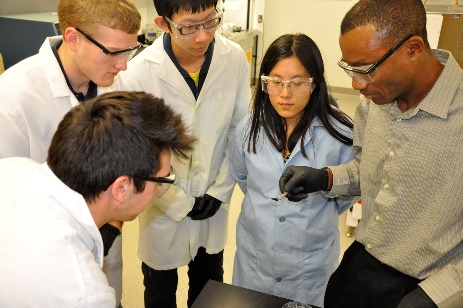Carbon Nanomaterials for Energy and Environmental Applications
 My research seeks to understand and improve the properties of nanomaterials, as well as exploit their extraordinary properties for energy and environmental applications. Specifically, we are developing methods to control the nucleation and orientation of nanocarbon materials (carbon nanotube and graphene), so their full potential can be realized. Control of the properties (e.g., orientation, lengths, chirality, and thicknesses) is critical since the intrinsic behavior of nanostructures is property dependent.
My research seeks to understand and improve the properties of nanomaterials, as well as exploit their extraordinary properties for energy and environmental applications. Specifically, we are developing methods to control the nucleation and orientation of nanocarbon materials (carbon nanotube and graphene), so their full potential can be realized. Control of the properties (e.g., orientation, lengths, chirality, and thicknesses) is critical since the intrinsic behavior of nanostructures is property dependent.
My research program focuses broadly on the rational design of catalysts for controlled and scalable growth of carbon nanomaterials and related nanostructures, with the goal of exploiting their unparalleled material properties in heterogeneous catalysis, energy storage/conversion and environmental remediation.
There are currently three ongoing projects in my research group:
(A) Scalable and Controlled Synthesis of Carbon Nanostructures by Catalytic CVD. Many important applications of carbon nanotubes (CNTs) and graphene require their synthesis on nontraditional substrates with exquisite control of their properties. We are developing an in-depth fundamental understanding of the nanoscale phenomena occurring during the growth process that will guide the fabrication of efficient catalysts and the control of the nanocarbon properties. Surface analytical techniques, including in situ and ex situ electron microscopy and advanced spectroscopy, are applied to probe the nucleation, growth and terminations mechanisms.
(B) Synthesis of Clean Fuels. Efficient catalyst systems are required to convert natural gas to higher hydrocarbons via Fischer-Tropsch synthesis. Such superior catalysts will require new supports that are characterized by high mesoporosity and thermal conductivity, as well as improved chemical stability. Given the outstanding material properties of CNTs and graphene, the use of tunable 3D nanocarbon hybrid structures as catalyst supports is being explored. The new support is expected to improve mass transport of reactants and products, heat dissipation during the exothermic reaction, and the stability of the catalyst.
(C) Electrochemical Energy Storage. Current efforts to increase ionic and electronic mobility in electrochemical energy storage systems have focused on decreasing the diffusion distance through the use of 3D nanostructured electrodes. Nanocarbon materials offer significant promise in synthesizing highly conductive, low-density 3D electrodes with tunable textural properties. We seek to establish inter-relationships between the properties of the 3D electrode and the electrochemical performance.
Contact
Placidus B. Amama
Professor
785-532-4318
pamama@k-state.edu